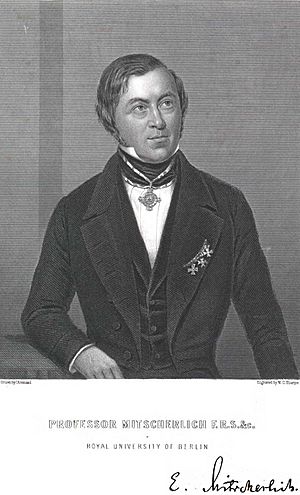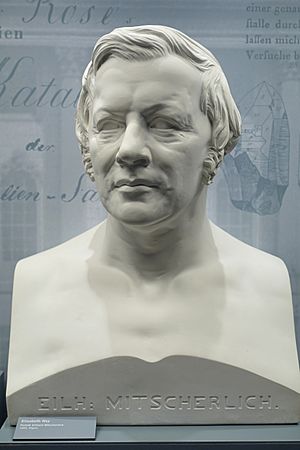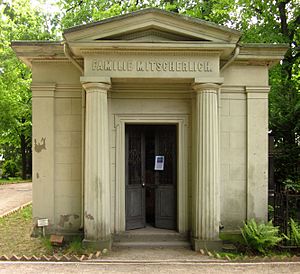Eilhard Mitscherlich facts for kids
Quick facts for kids
Eilhard Mitscherlich
|
|
|---|---|

Eilhard Mitscherlich (1794–1863)
|
|
| Born | 7 January 1794 |
| Died | 28 August 1863 (aged 69) |
| Nationality | German |
| Alma mater | University of Göttingen University of Berlin University of Stockholm |
| Known for | Mitscherlich's law Mitscherlichite Azobenzene Goniometer Selenic acid |
| Awards | Pour le Mérite for Sciences and Arts (1842) Royal Medal (1829) ForMemRS (1828) |
| Scientific career | |
| Fields | Chemist |
| Institutions | University of Berlin |
| Doctoral advisor | Friedrich Stromeyer |
| Doctoral students | Heinrich Gustav Magnus |
Eilhard Mitscherlich (born January 7, 1794 – died August 28, 1863) was an important German chemist. He is best known for discovering something called crystallographic isomorphism in 1819. This discovery helped us understand how different chemicals can have similar crystal shapes.
Contents
Early Life and His Path to Science
Eilhard Mitscherlich was born in Neuende, which is now part of Wilhelmshaven, Germany. His father was a pastor. His uncle, Christoph Wilhelm Mitscherlich, was a famous scholar at the University of Göttingen.
Eilhard first studied philology, which is the study of language and literature, especially Persian. He even wanted to travel to Persia. However, when Napoleon Bonaparte left power in 1814, his travel plans changed.
He then decided to study medicine at Göttingen. While there, he discovered a strong interest in chemistry. This new passion made him change his career path completely.
In 1818, Mitscherlich moved to Berlin. He worked in a lab and studied different chemical compounds like phosphates and arsenates. He noticed that these compounds, even though they were different, often formed crystals with the same shape. This observation led to his big idea about isomorphism.
Because of his promising work, a famous chemist named Jöns Jacob Berzelius suggested Mitscherlich should become a professor at the University of Berlin. Mitscherlich spent some time studying in Berzelius's lab in Stockholm before returning to Berlin. In 1822, he became a professor of chemistry at the university.
What is Isomorphism?

Mitscherlich's most famous discovery was the idea of isomorphism. This word comes from Greek words meaning "equal shape."
He noticed that certain chemical compounds, even if they had different elements, could form crystals with very similar shapes. For example, he found that phosphates and arsenates often crystallized in the same way. This was a big deal because it showed a hidden connection between different chemicals based on their structure.
He also studied how crystals change with temperature. He found that some crystals, when heated, expand differently in various directions. This led him to discover another important concept called polymorphism.
Understanding Polymorphism
Polymorphism is when a single chemical compound can exist in more than one crystal form. A good example is sulfur. Sulfur can form different types of crystals depending on the temperature and how it's made. Mitscherlich's work helped explain why minerals like calcite and aragonite have the same chemical makeup but different crystal shapes.
Later Discoveries and Contributions

Mitscherlich continued his important research throughout his life.
- Vapor Densities: In 1833, he carefully measured the densities of many gases and vapors. His findings supported a law by Joseph Louis Gay-Lussac about how gases combine.
- Catalysis: He studied how diethyl ether is made from ethanol and sulfuric acid. He noticed that the sulfuric acid helped the reaction happen faster without being used up itself. This observation helped another chemist, Jöns Jacob Berzelius, come up with the term "catalysis" for this kind of chemical helper.
- Selenic Acid: In 1827, he created selenic acid. He then showed that its salts (compounds formed from the acid) had crystal shapes similar to sulfates. This further supported his ideas about isomorphism.
- Organic Chemistry: Later in his career, Mitscherlich focused on organic chemistry, which is the study of carbon-containing compounds. He investigated substances like benzene and how they relate to other chemicals.
- Geology: He was also interested in geology, especially volcanoes. He visited the Eifel region in Germany many times to try and understand why volcanoes erupt. Although he didn't publish much on this topic during his lifetime, his notes were published after he passed away.
Mitscherlich was a highly respected scientist. He was an honorary member of many scientific groups around the world. He received the gold medal from the Royal Society of London for his discovery of the law of isomorphism.
His Final Years and Legacy
Eilhard Mitscherlich started having heart problems in 1861. He continued working until late 1862. He passed away in 1863 near Berlin and was buried in the St Matthäus Kirchhof Cemetery.
He published about 76 scientific papers, mostly in important German and French science journals. He also started writing a large chemistry textbook called Lehrbuch der Chemie, which was very influential. Even though he didn't finish all editions, it was a major work in chemistry education. His complete works were published in Berlin in 1896.
See also
 In Spanish: Eilhard Mitscherlich para niños
In Spanish: Eilhard Mitscherlich para niños
- Ammonium permanganate
- Ethyl sulfate
- Manganate


